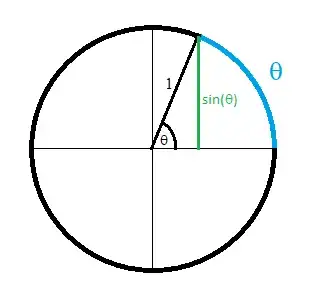I was working on a proof in complex numbers which goes like this:
Let $z_1=r_1\left(\cos \theta_1+i \sin \dot{\theta}_1\right)$ and $z_2=r_2\left(\cos \theta_2+i \sin \theta_2\right)$. Then $\left|z_1\right|=r_1,\left|z_2\right|=r_2, \arg \left(z_1\right)=\theta_1$ and $\arg \left(z_2\right)=\theta_2$. It is given that $\left|z_1\right| \leq 1$ and $\left|z_2\right| \leq 1$. Therefore, $0 \leq r_1 \leq 1$ and $0 \leq r_2 \leq 1$ Now:
\begin{aligned} \left|z_1+z_2\right|^2 & =r_1{ }^2+r_2{ }^2-2 r_1 r_2 \cos \left(\theta_1-\theta_2\right) \\ & =r_1{ }^2+r_2{ }^2-2 r_1 r_2+2 r_1 r_2-2 r_1 r_2\left(\cos \left(\theta_1-\theta_2\right)\right. \\ & =\left(r_1-r_2\right)^2+2 r_1 r_2\left\{1-\cos \left(\theta_1-\theta_2\right)\right\} \\ & =\left(r_1-r_2\right)^2+4 r_1 r_2 \sin ^2\left(\frac{\theta_1-\theta_2}{2}\right) \end{aligned}
$\begin{aligned} & \Rightarrow\left|z_1+z_2\right|^2 \leq\left(r_1-r_2\right)^2+4 \sin ^2\left(\frac{\theta_1-\theta_2}{2}\right)\left[\because r_1=\left|z_1\right| \leq 1\right. \\ & \left.\text { and } r_2=\left|z_2\right| \leq 1\right] \\ & \Rightarrow\left|z_1+z_2\right|^2 \leq\left(r_1-r_2\right)^2+4\left(\frac{\theta_1-\theta_2}{2}\right)^2 \\ & \left.\Rightarrow \mid \because \sin \left(\frac{\theta_1-\theta_2}{2}\right)<\left(\frac{\theta_1-\theta_2}{2}\right)\right] \\ & \Rightarrow\left|z_1+z_2\right|^2 \leq\left(r_1-r_2\right)^2+\left.\left(\theta_1-\theta_2\right)^2\right|^2 \leq\left(\left|z_1\right|-\left|z_2\right|\right)^2+\left\{\arg \left(z_1\right)-\arg \left(z_2\right)\right\}^2\end{aligned}$
I am not sure why sin of something is always less than that something. as stated in the proof.
